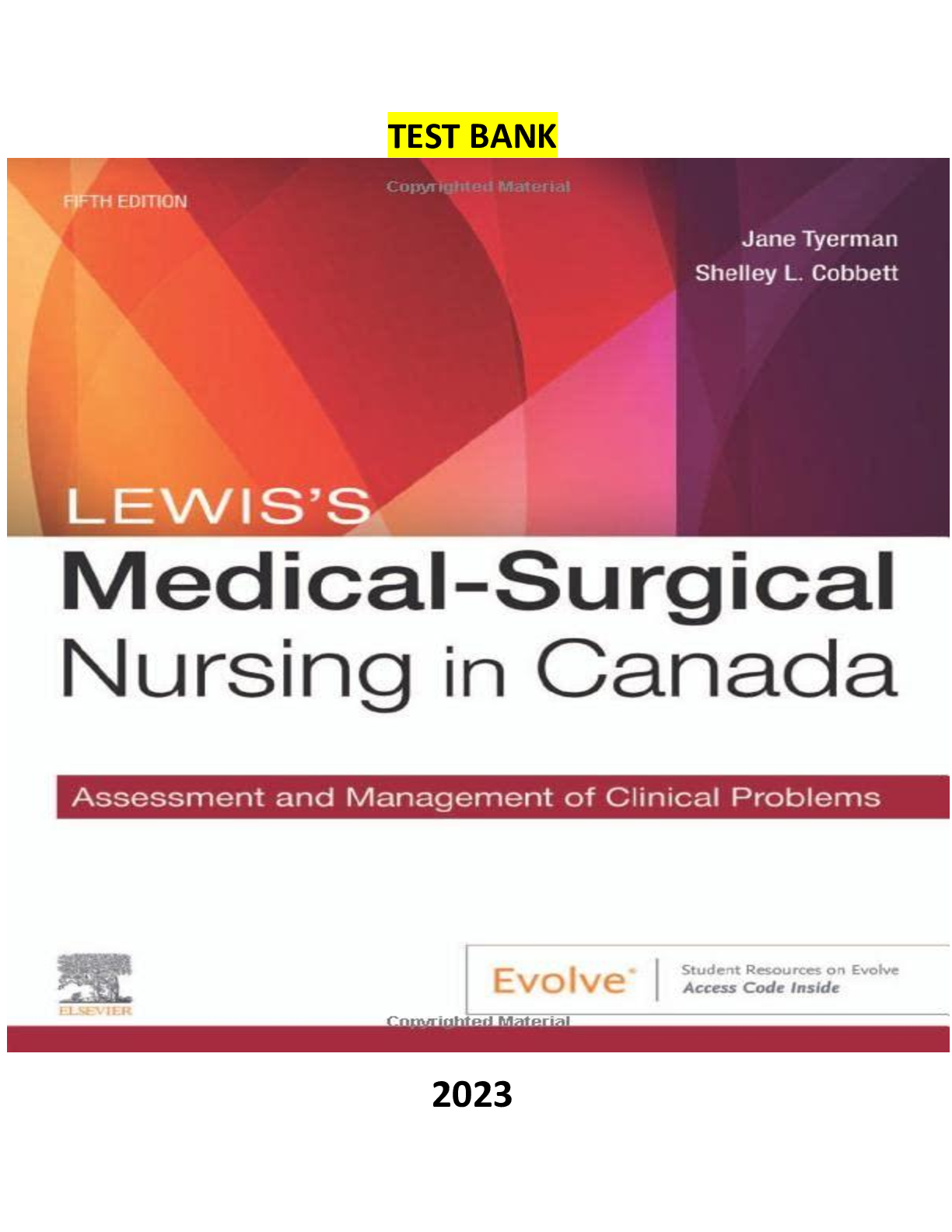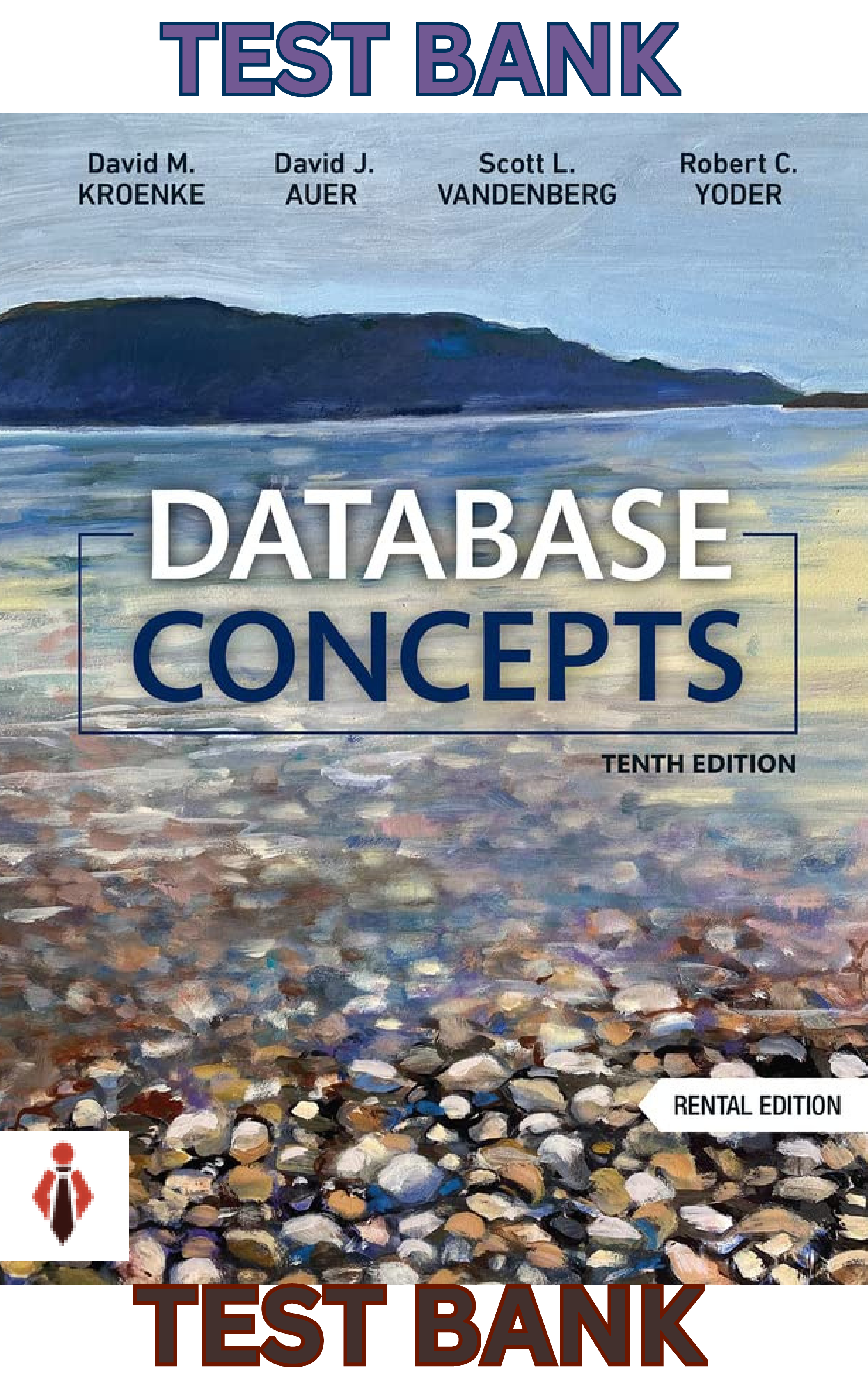History > TEST BANK > COMPLETE - Elaborated Test Bank for Worlds Together, Worlds Apart-A History of the World from the Be (All)
COMPLETE - Elaborated Test Bank for Worlds Together, Worlds Apart-A History of the World from the Beginnings of Humankind to the Present 6Ed.by Jeremy Adelman, Elizabeth Pollard & Robert Tignor. ALL Chapters 1-11 Included and updated for 2023
Document Content and Description Below
COMPLETE - Elaborated Test Bank for Worlds Together, Worlds Apart-A History of the World from the Beginnings of Humankind to the Present 6Ed.by Jeremy Adelman, Elizabeth Pollard & Robert Tignor. ALL C... hapters 1-11 Included and updated for 2023 COMPLETE - Elaborated Test Bank for Worlds Together, Worlds Apart-A History of the World from the Beginnings of Humankind to the Present 6Ed.by Jeremy Adelman, Elizabeth Pollard & Robert Tignor. ALL Chapters 1-11 Included and updated for 2023 TABLE OF CONTENTS Chapter 1. Becoming Human (Pre-History and the Peopling of the Earth) Chapter 2. Rivers, Cities, and First States, 3500–2000 bce (Comparing First Cities) Chapter 3. Nomads, Territorial States, and Microsocieties, 2000–1200 bce (Comparing First States) Chapter 4. First Empires and Common Cultures in Afro-Eurasia, 1250–325 bce (Comparing First Empires and Beginnings of Judiasm) Chapter 5. Worlds Turned Inside Out, 1000–350 bce (The Axial Age) Chapter 6. Shrinking the Afro-Eurasian World, 350 bce–250 ce (Building of the Silk Road and Beginnings of Buddhism) Chapter 7. Han Dynasty China and Imperial Rome, 300 bce–300 ce (Comparing Han and Roman Empires) Chapter 8. The Rise of Universalizing Religions, 300–600 ce (The Rise of Christianity, the Spread of Buddhism, and the Beginnings of Common Cultures) Chapter 9. New Empires and Common Cultures, 600–1000 ce (The Rise of Islam and Comparing the Relationships between Empires and Religions) Chapter 10. Becoming “The World,” 1000–1300 ce (The Emergence of the Worlds We Know Today) Chapter 11. Crises and Recovery in Afro-Eurasia, 1300–1500 (The Spread of the Black Death across Afro-Eurasia) SAMPLE QUESTIONS: 1. Which of the following is an accurate depiction of creation narratives? a. Creation narratives demonstrate that the world has existed for 13.75 billion years. b. Creation narratives exist for all societies. c. Creation narratives place the origins of humans in Africa. d. Creation narratives do not conceive that humans were ever related to apes. ANS: D DIF: Moderate REF: p. 5 OBJ: 1 TOP: 1 MSC: Analyzing 2. Which of the following is an important physical distinction between hominins and other animals? a. hunting prowess c. opposable thumbs b. language d. bipedalism ANS: D DIF: Easy REF: p. 8 OBJ: 2 TOP: 2 MSC: Remembering 3. When did significant cultural differences emerge among humans? a. They developed while they were hunter-gatherers. b. They developed when hominins moved out of Africa. c. They developed with the advent of settled agriculture. d. They developed when humans began to produce art. ANS: C DIF: Moderate REF: p. 4 OBJ: 4 TOP: 3 MSC: Remembering 4. Which of the following allowed hominins to create and use tools? a. opposable thumbs c. creation myths b. the development of language d. increased powers of observation ANS: A DIF: Moderate REF: p. 9 OBJ: 2 TOP: 2 MSC: Understanding 5. Which of the following is true of hominins such as Australopithecus africanus? a. Hominins were only found in southern Africa. b. Hominins were the only animal species to adapt to changing environments. c. Hominins emerged between 6 and 7 million years ago. d. Hominins developed into different species. ANS: D DIF: Moderate REF: p. 8 OBJ: 2 TOP: 2 MSC: Understanding Chapter 1 Becoming Human ◆ 3 2 6. Why was Australopithecus africanus unique, compared to other animals of its time? a. It possessed a brain capacity equal to that of modern humans. b. It was bigger than other predators. c. It was faster than other predators. d. It walked on two legs. ANS: D DIF: Moderate REF: p. 9 OBJ: 2 TOP: 2 MSC: Remembering 7. What was the single trait that marks the most successful early hominins, compared to those hominins that died out? a. large brain capacity b. the ability to produce fire c. the ability to adapt to changing physical environments d. continuous fertility ANS: C DIF: Easy REF: p. 8 OBJ: 2 TOP: 2 MSC: Remembering 8. What early hominin capability fostered the abilities to create tools and to migrate away from hostile environments? a. refined cognitive abilities c. artistic expression b. language use d. control of fire ANS: D DIF: Easy REF: p. 9 OBJ: 2 TOP: 2 MSC: Remembering 9. Which of the following accurately describes the social patterns of early hominins? a. They lived in nuclear family units. b. They communicated primarily through gestures. c. They coordinated several family units to hunt large predators. d. They created elaborate stories around campfires. ANS: B DIF: Moderate REF: p. 9 OBJ: 2 TOP: 2 MSC: Analyzing 10. Which of the following best describes hominins in eastern Africa between 3 and 4 million years ago? a. A number of hominin species coexisted, most of whom would continue to survive to the present day. b. A number of hominin species coexisted, most of whom would provide the genetic base of modern humans. c. A number of hominin species coexisted, but most would not survive to the present day. d. All the hominin species would eventually die out, setting the stage for modern humans to evolve independently. ANS: C DIF: Difficult REF: p. 8 OBJ: 2 TOP: 2 MSC: Analyzing 4 ◆ Chapter 1 Becoming Human 3 11. What best distinguishes Homo habilis from earlier hominins? a. Homo habilis intentionally fashioned tools to butcher animals. b. Homo habilis built shelters from wood for protection. c. Homo habilis developed an elaborate creation narrative. d. Homo habilis migrated to the Americas. ANS: A DIF: Difficult REF: p. 12 OBJ: 2 TOP: 2 MSC: Remembering 12. Which of the following best describes Homo erectus children? a. They had a larger brain capacity than earlier hominins because their mothers had wider pelvises. b. They were ignored by clan members until they could hunt and contribute to the food supply. c. They depended on their mothers for food and care for many years. d. Older females, not including their mothers, often tried to kill Homo erectus children. ANS: C DIF: Difficult REF: p. 13 OBJ: 2 TOP: 2 MSC: Analyzing 13. Why was the mastery of fire by early hominins significant? a. Fire repelled hominin predators. b. Fire increased hominin capability to hunt for large game. c. Fire allowed hominins to create bronze tools. d. Fire served as a gathering point for small hominin communities. ANS: D DIF: Easy REF: p. 13 OBJ: 2 TOP: 2 MSC: Remembering 14. Which of the following skills was developed most recently by hominins? a. tool making c. complex language b. bipedalism d. use of fire ANS: C DIF: Easy REF: p. 14 OBJ: 3 TOP: 3 MSC: Remembering 15. What was a major consequence of the large-scale ecological changes in Africa around 60,000 and 10,000 years ago? a. Spreading ice sheets led to the death of many animals hunted by early hominins. b. Australopithecus africanus survived by building structures to store water and grain. c. Neanderthals and Cro-Magnons fought wars to control game herds. d. Bigger-brained hominins such as Homo sapiens survived because they adapted to changing environments. ANS: D DIF: Moderate REF: p. 14 OBJ: 3 TOP: 2 MSC: Understanding Chapter 1 Becoming Human ◆ 5 4 16. Which of the following was a consequence of Homo sapiens migration out of Africa between 50,000 and 12,000 BCE? a. Homo sapiens developed distinct regional cultures in response to different environments. b. Some Homo sapiens encountered hostile Homo habilis bands in Europe. c. Homo sapiens did not move into central Asia because there were no large game animals. d. Homo sapiens sailed from island to island in the Pacific until they arrived in South America around 30,000 BCE. ANS: A DIF: Moderate REF: p. 15 OBJ: 3 TOP: 2 MSC: Understanding 17. Who were the Cro-Magnons? a. Neanderthals who survived in isolated locations into the twentieth century b. Homo sapiens who replaced the Neanderthals in Europe c. descendants of Homo habilis who taught tool-making skills to the Neanderthals d. the last Neanderthal clan, which became extinct around 30,000 BCE in Spain ANS: B DIF: Easy REF: p. 18 OBJ: 3 TOP: 2 MSC: Remembering 18. What did early Homo sapiens hunter-gatherers do? a. They spent nearly every hour of the day foraging for food. b. They formed small bands that were relatively egalitarian. c. They avoided social behaviors such as friendly competitions. d. They were male-dominated societies, as men provided most of the food. ANS: B DIF: Easy REF: p. 20 OBJ: 3 TOP: 2 MSC: Remembering 19. Which of the following characteristics may have indicated that early Homo sapiens defined themselves as separate from the other parts of nature? a. tool-making techniques such as chipping and flaking b. artworks such as cave paintings and small statuettes c. communicating by gestures and simple sounds d. strong gender roles ANS: B DIF: Moderate REF: p. 22 OBJ: 3 TOP: 3 MSC: Understanding 20. The discovery of which of the following led scientists to believe that early humans had developed a mythology? a. runes or simple symbolic notation b. decorated bronze tools c. statuettes of enormously fat and pregnant females d. statuettes of muscular men ANS: C DIF: Moderate REF: p. 22 OBJ: 3 TOP: 3 MSC: Remembering 6 ◆ Chapter 1 Becoming Human 5 21. Which of the following both integrated communities for survival and allowed knowledge to be transmitted across space and time? a. use of fire c. bipedalism b. more complex tools d. complex language ANS: D DIF: Easy REF: p. 24 OBJ: 3 TOP: 3 MSC: Remembering 22. What was the key development that allowed Homo sapiens to engage dynamically with their environment? a. the mastery of fire b. the crafting of tools c. the development of complex language d. the domestication of plants ANS: C DIF: Easy REF: p. 24 OBJ: 3 TOP: 3 MSC: Remembering 23. Which of the following statements about human language is correct? a. It expanded into nineteen separate language families as humans moved out of Africa. b. It is composed of distinctive sounds called phonemes that many animals can produce with greater range and diversity than humans. c. It has a limited number of phonemes in its vocal register, which limits the range of subtle and complex ideas humans can express. d. It differs only marginally from the language systems of other apes. ANS: A DIF: Moderate REF: p. 24 OBJ: 3 TOP: 3 MSC: Remembering 24. Which of the following accurately describes the first plant cultivation? a. It began around 50,000 years ago. b. Cultivation originated independently in several different locations. c. Overpopulation caused by the effectiveness of new tools for hunting large game animals led to the need for new food sources. d. Cultivation originated in one region and spread to adjacent regions over time. ANS: B DIF: Easy REF: p. 24 OBJ: 4 TOP: 2 MSC: Remembering 25. Which of the following is true of the domestication of animals? a. It probably first occurred in central America, where wild dogs attached themselves to small human clans to obtain discarded animal carcasses. b. It was more difficult and less reliable than hunting game to obtain protein. c. It led some communities to move to grassy steppe lands and develop pastoralism to provide sufficient food supplies for their herds. d. It tended to disrupt relationships within communities, as pastoralists and agriculturalists competed for the same land. ANS: C DIF: Moderate REF: p. 25 OBJ: 4 TOP: 4 MSC: Remembering Chapter 1 Becoming Human ◆ 7 6 26. Around 12,000 years ago, increasing populations and changing climate conditions were two of the major reasons that humans did what? a. They learned to domesticate plants and animals. b. They discovered fire. c. They created music and art. d. They migrated out of Africa to Afro-Eurasia. ANS: A DIF: Moderate REF: p. 24 OBJ: 4 TOP: 4 MSC: Understanding 27. Which of the following was an advantage of pastoralism? a. Pastoralists were more numerous than agriculturalists because their diets consisted of more protein. b. Pastoralists could exist in isolation from the turmoil of settled village and urban life. c. Pastoralists developed rich and numerous material possessions. d. Pastoralists domesticated horses, giving them decisive advantages in transportation and warfare. ANS: D DIF: Moderate REF: p. 28 OBJ: 4 TOP: 4 MSC: Remembering 28. Why were nomadic pastoralists important to settled agriculturalists? a. They provided a vast library of historical records. b. They left important records that influenced agricultural innovation. c. They had so little interaction with agricultural communities that farmers came to think of them as powerful mythological beings. d. They transmitted ideas, products, and peoples across long distances, linking them with a wider world. ANS: D DIF: Difficult REF: p. 28 OBJ: 4 TOP: 4 MSC: Applying 29. When did the first agricultural revolution occur? a. It occurred in southern China as rice cultivation developed. b. It occurred as cooling temperatures across the globe forced hunters and gatherers to innovate with agriculture in order to survive. c. It occurred around 9000 BCE as settled villages began to cultivate domesticated cereals and herd animals. d. It occurred when migratory populations carried seeds to new regions where they grew abundantly. ANS: C DIF: Easy REF: p. 28 OBJ: 4 TOP: 4 MSC: Understanding 8 ◆ Chapter 1 Becoming Human 7 30. To what does the “Fertile Crescent” refer? a. It refers to the Rift Valley region, in which many early hominin bones have been discovered. b. It refers to a region of Southwest Asia with rich soils and regular rainfall in which the agricultural revolution first appeared. c. It refers to the regions of southern France and northern Spain, where many cave paintings have been discovered. d. It refers to the region of Southeast Asia, where scholars found evidence of rice cultivation. ANS: B DIF: Easy REF: p. 29 OBJ: 4 TOP: 4 MSC: Remembering 31. Which crops formed the basis of village agriculture in China? a. millet and sorghum c. maize and potatoes b. yams and rice d. rice and millet ANS: D DIF: Moderate REF: p. 30 OBJ: 4 TOP: 4 MSC: Remembering 32. The first humans in North America pursued which survival strategy? a. They hunted large mammals using chipped blades and pointed spears. b. They hunted large mammals using domesticated horses and bow technology. c. They relied on pastoralism, especially domesticated sheep and goats. d. They relied on agriculture, especially domesticated maize, squash, and beans. ANS: A DIF: Moderate REF: p. 30 OBJ: 4 TOP: 4 MSC: Remembering 33. What happened to early humans in the Americas? a. They domesticated pigs, sheep, and cattle. b. They experienced rapid population growth as they abandoned hunting and gathering in favor of settled agriculture. c. They developed extensive traditions of watercraft on the coast of Peru to promote trade along the coast. d. They adapted to different ecological niches and created new subsistence strategies. ANS: D DIF: Moderate REF: pp. 30–31 OBJ: 4 TOP: 4 MSC: Understanding 34. How did the people of the Americas compare with Afro-Eurasians? a. People of the Americas were more scattered and isolated from each other. b. People of the Americas were unable to adapt to local ecozones. c. People of the Americas did not develop refined agricultural techniques. d. People of the Americas more frequently domesticated animals as a food source. ANS: A DIF: Moderate REF: p. 33 OBJ: 4. [Show More]
Last updated: 1 year ago
Preview 1 out of 321 pages

Buy this document to get the full access instantly
Instant Download Access after purchase
Add to cartInstant download
We Accept:

Reviews( 0 )
$37.50
Document information
Connected school, study & course
About the document
Uploaded On
Apr 09, 2023
Number of pages
321
Written in
Additional information
This document has been written for:
Uploaded
Apr 09, 2023
Downloads
0
Views
54













, 5e Robert Strayer, Eric Nelson.png)
, 5e Robert Strayer, Eric Nelson.png)
, 5e Robert Strayer, Eric Nelson.png)









